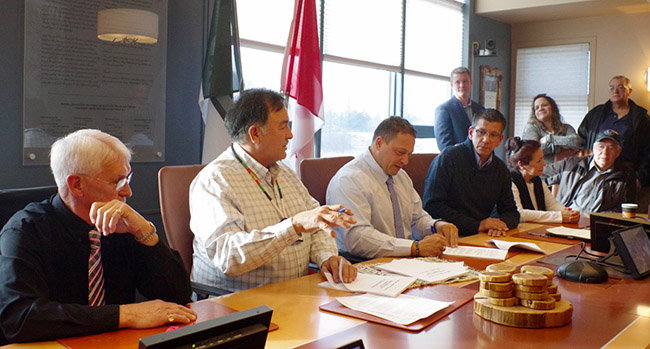Grand Trunk Pacific Settlement Agreement signed with feds

By Rick Garrick
FORT WILLIAM FIRST NATION – Fort William First Nation recently initialled the Grand Trunk Pacific Settlement Agreement with the federal government over more than 1,600 acres of land that was expropriated for a railway terminus.
“This is a historical day for Fort William First Nation,” says Fort William Chief Peter Collins. “If you look at the history of the taking, the largest taking of First Nation land by a rail company in Canadian history, today is another step in the right direction. All the documents have been finalized and initialled, so the next step for us is now the (final) ratification vote by our members.”
Collins initialled the agreement along with the David Snowdon, negotiator with Specific Claims Branch, Indigenous and Northern Affairs Canada, on Dec. 23 in the Fort William Council Chambers. The ratification vote is scheduled for Feb. 18.
“Our community is happy — they’ve been waiting patiently for us to get this done,” Collins says. “Once it is all finalized we will be very happy.”
Collins says the community still has to decide how to use the $98,933,310 global settlement offer they previously received from the federal government on March 30, 2016. The offer includes a contribution towards legal, negotiation and ratification costs as well as land acquisition, environmental assessment and survey costs.
“We have to consult with our members, but we’ve done a lot of that already,” Collins says. “There will be a per capita distribution to our members and the rest will go into economic development and education.”
Fort William first submitted the GTP claim for negotiation with Canada in 1999, and Canada accepted the claim in 2002 on the basis that the land was sold for less than it was worth in 1905. The land included the community’s entire Mission site, including homes, farms, the church and the traditional burial site.
“They endured some real tragic times in our community when our community was uprooted, our houses, our community, our churches, our schools, our farmlands and most importantly our deceased that were exhumed from their resting place and moved to a different location in our community,” Collins says. “We’ve had the opportunity to gather and tour through the property to show (government representatives) some foundations that are still on that property.”
Collins says the tour gave the government representatives a better understanding of how the land taking impacted the community in 1905.
“What it meant for our community is that you take us off prime real estate, prime farm lands and access to the waterways where we lived and travelled on,” Collins says. “I think this country needs to realize what they’ve done to this community.”
The land was initially appropriated by Canada in 1905 for a GTP railway terminus, which was never completed. The GTP later went bankrupt and the rail line was taken over by Canada in 1920. Fort William First Nation Development Corporation regained ownership of 1,100 acres of the land in 1999 through direct negotiations with Canadian National Railway.
“I’m glad that I am a part of this,” Collins says. “I was glad when the land was returned to us in 1999 and I’m glad I’ve seen the end results today.”
Fort William plans to re-establish the original site where their community once stood as a historical landmark.
“We’re going to try to protect the land where our original village was and maybe make it a historical site,” Collins says. “I showed Canada the foundations from our churches and schools that are still there today.”


